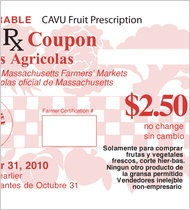
A Prescription For Veggies?
Yea for the Commonwealth of Massachusetts and the docs at three medical centers who are writing prescriptions for produce for families with weight problems.
Families with low incomes get coupons for produce that they can redeem at local farmers’ markets. The value of a coupon is $1 per person per day. It seems like a small amount, but with the coupons a family of four can get $120 of fresh produce a month.
What’s The Rationale?
This objective is to get kids to increase their fruit and veggies by one serving a day. It is also seen as a opportunity to introduce the children, who have a limited range of exposure, to real food. The coupon is somewhat symbolic – the $1 coupon competes with the 99 cent fast food meals so familiar to these kids.
Obesity Has Tripled
According to the CDC, childhood obesity has more than tripled over the last 30 years. Sedentary lifestyles and limited access to fresh, healthy food are seen as reasons for this rapid increase. Along with handing out the coupons, the doctors will follow the families receiving the coupons to determine how their eating patterns are affected. They will also monitor health parameters like weight and body mass index (BMI).
The hope is, too, that the families become invested in good nutritional practices by hanging out with both the farmers and the consumers at the farmers’ market – and that they then develop a preference for shopping at these types of markets rather than fast food restaurants, supermarkets, big box and convenience stores.
Will It Help Farmers’ Markets, Too?
It may also help the farmers’ markets compete with the fast food vendors who entice kids and families with cheap calories and cheap meals.
The number of farmers’ markets has dramatically increased: from 1,755 in 1994 to more than 5,200. Although US farmers’ markets generate over $1 billion in annual sales, they are low on the totem pole compared to the fast food industry which brought in over $22.79 billion in 2008.
Healthy Eating Patterns And Lifestyles
As the mayor of Boston said, “When I go to work in the morning, I see kids standing at the bus stop eating chips and drinking a soda. I hope this will help them change their eating habits and lead to a healthier lifestyle.”





